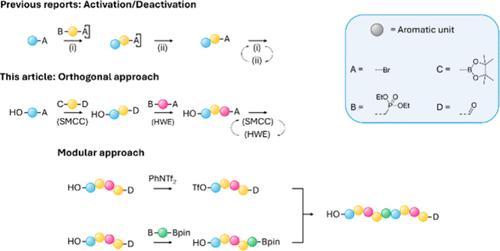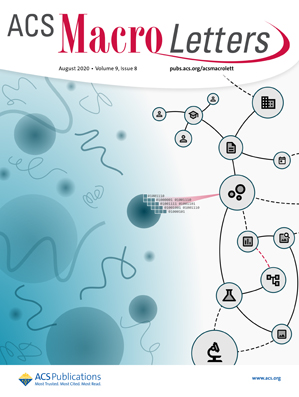开发序列定义共轭大分子的多功能策略:实现可调光电特性的强大工具
IF 5.2
Q1 POLYMER SCIENCE
引用次数: 0
摘要
序列定义共轭聚合物是聚合物科学的一个前沿领域,它融合了生物大分子的精确性、合成聚合物的多功能性以及共轭体系的独特性能。早期的报道侧重于激活/失活策略,而这封信则首次提出了开发序列定义共轭大分子(CMs)的正交方法,即在每个反应步骤中加入一种新单体。在 CM 中,主单体序列精心决定了光电特性。结构缺陷、链长、分散性、官能团、拓扑结构和骨架中使用的单体等特征都要逐步加以仔细考虑和控制,并提供光学数据,以支持在 CM 中采用序列定义方法的必要性。此外,还引入了一种开创性的可重复模块化方法,将不同的正交开发序列连接起来。这种方法提高了效率,加快了合成过程,促进了全面的结构-性能分析,为具有破纪录性能的可调材料铺平了道路。本文章由计算机程序翻译,如有差异,请以英文原文为准。

Versatile Strategy to Develop Sequence-Defined Conjugated Macromolecules: A Powerful Tool toward Tunable Optoelectronic Properties
Conjugated sequence-defined polymers represent a cutting-edge area of polymer science, merging the precision of biological macromolecules with the versatility of synthetic polymers and the unique properties of conjugated systems. While early reports focused on activation/deactivation strategies, this Letter presents the first orthogonal approach to developing sequence-defined conjugated macromolecules (CMs), incorporating a new monomer at each reaction step. In CMs, the primary monomer sequence meticulously determines the optoelectronic properties. Step-by-step, features such as structural defects, chain length, dispersity, functional groups, topology, and monomers used in the backbone are carefully considered and controlled, with optical data provided to support the necessity of sequence-defined approaches in CMs. Additionally, a pioneering and repeatable modular approach is introduced, connecting different orthogonally developed sequences. This method enhances efficiency and accelerates the synthesis process, facilitating comprehensive structure–property analyses and paving the way for tunable materials with record-breaking properties.
求助全文
通过发布文献求助,成功后即可免费获取论文全文。
去求助
来源期刊
CiteScore
10.40
自引率
3.40%
发文量
209
审稿时长
1 months
期刊介绍:
ACS Macro Letters publishes research in all areas of contemporary soft matter science in which macromolecules play a key role, including nanotechnology, self-assembly, supramolecular chemistry, biomaterials, energy generation and storage, and renewable/sustainable materials. Submissions to ACS Macro Letters should justify clearly the rapid disclosure of the key elements of the study. The scope of the journal includes high-impact research of broad interest in all areas of polymer science and engineering, including cross-disciplinary research that interfaces with polymer science.
With the launch of ACS Macro Letters, all Communications that were formerly published in Macromolecules and Biomacromolecules will be published as Letters in ACS Macro Letters.

 求助内容:
求助内容: 应助结果提醒方式:
应助结果提醒方式:


